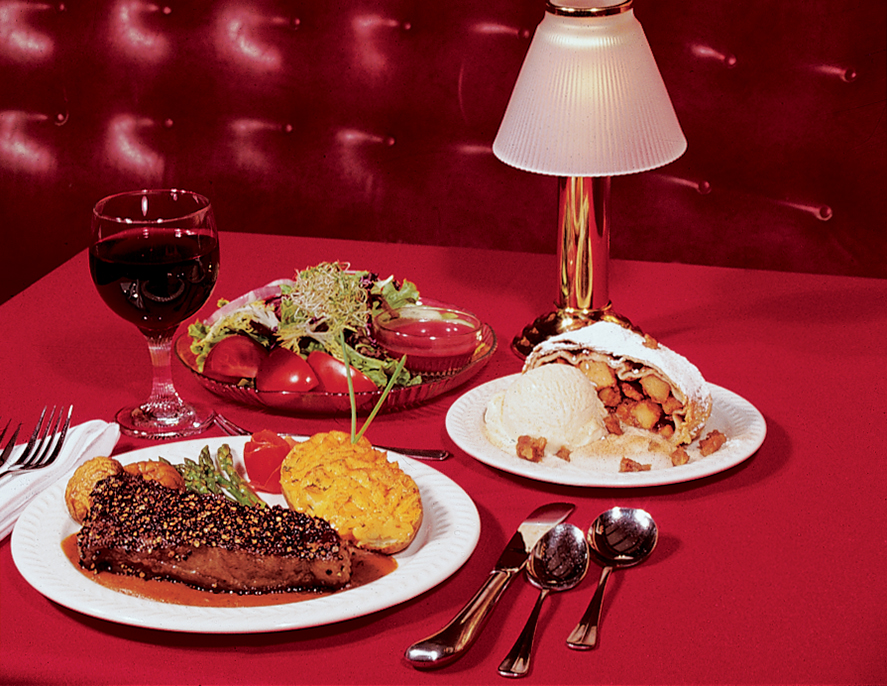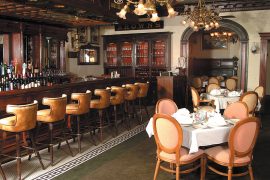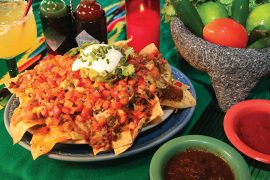The Elephant Walk restaurant offers fine dining and a taste of the past.
By Megan Jones
HQ 32 | SUMMER 1998
Happy hour — downtown Huntington. Two men sit at the bar of a new supper club, drinking martinis and debating the day’s news.
“Everybody’s kids are going Beatles crazy, falling all over those baby-faced British boys,” one says. “Some little Asian country, Vietnam, you know — looks like trouble.” They had scarcely started when their wives, busy from an afternoon’s shopping at Belle’s, are escorted in. It’s the first time the women have entered the elegant hotel’s club, and they remark, “Isn’t it cute?”
When the original Elephant Walk opened as part of the Hotel Frederick in 1964, only a select crowd could partake of the unique wining and dining atmosphere created by Huntington businessman Bill Ritter and his partner, architect/designer John Jenkins. It was a private club, open only for members and their guests.
In February 1998, 25 years after the club closed, a new Elephant Walk emerged, a little piece of Huntington’s history revised that anyone can experience. And while the restaurant may have a new owner in Rick Coleman, patrons of the old Elephant Walk will find themselves in very familiar surroundings.
As president of Central Realty, the company that owned the Hotel Frederick, Ritter wanted to attract more business by developing a club for the lobby. He and Jenkins would go out on their boats and toss around ideas for a theme, searching for a distinct and memorable motif.
“And then one night I woke up,” Ritter said. “On my nightstand there was a book called Elephant Walk.”
One woman hands her husband a golden passkey stamped with an elephant and an identification number, and he puts it in his pocket. “Did you see the elephant’s head handle on the door?” he asks. Behind their chairs, a corps of golden elephants parades single file around the wall.
The Elephant Walk soon became distinctive indeed, with custom-made artwork from up and down the East Coast. After Jenkins sketched some patterns for the golden elephants on the walls, his designs were sent to New York, where molds were cast. The molds were then sent back to Huntington and painted gold— except for one that hangs, still bare, on the wall behind Ritter’s Central Realty desk.
After dinner, they again gather at the copper-topped bar and sit on gray elephant-foot stools. “Another round of martinis,” one tells the bartender, and the group settles back to enjoy the five-piece band. The elephantine effects keep catching their eyes — some elephant paintings and a path of black elephant footprints with white toenails tracking the carpet. “The mural is my favorite,” one woman says to her husband. She likes the whimsical group of elephants dancing with top hats and canes.
A big Buddha statue, whose inscription invites patrons to rub his tummy and make a wish, also came from New York, while the heavy chandeliers came from Florida. And as for the dancing elephant mural?
Ritter and Jenkins admired the work of Florida artist Phil Brinkman, but he was less than eager to come to West Virginia. After some coaxing, Brinkman agreed to paint the mural on one condition: a mug of beer had to be placed within easy reach of his stepladder at all times. A hotel bellboy was commissioned to keep the artist’s “inspiration” fresh. He finished in three days, and drew a bee in the glass of the center elephant in Ritter’s honor.
The couples say goodbye to some friends, pick up their coats and prepare to leave, following the elephant tracks to the exit. One woman starts laughing as they approach the door. Look at the handle on this side,” she exclaims. “It’s an elephant’s behind.”
From its 1964 opening, the Elephant’s Walk attracted a loyal clientele. Private clubs were common then, although Ritter said the Athletic Club was the only other real option in the city. Members would call ahead to the bartenders and ask for particular bottles to be placed in their lockers, from which their drinks would be poured. No cash exchanged hands. All business was done by credit tallied up at the end of each month. Guests who had traveled from cities such as New York and Chicago were sometimes a little surprised by the Elephant Walk, Ritter said.
“They thought it was like going back in time,” he said. “They’d act like it was some kind of speakeasy.”
Maybe the biggest surprise, for guests and members alike, was the time Ritter and Jenkins managed to expand upon the club’s decor — by about several thousand pounds.
Soon after opening, the two decided to promote the club by booking an elephant named Shirley from the visiting circus. Just before noon, the elephant squeezed through the double doors.
“She got down on her knees and crawled on in,” Ritter said. “You couldn’t see a speck of daylight. You had to see the expressions on their faces to believe it,” he said, laughing. “My only fear was that she would mess on the carpet, but she didn’t.”
The Hotel Frederick closed in 1973, and the Elephant Walk space was leased to a Chinese restaurant called Ming’s, whose owners left the decor intact.
But Ming’s closed almost two years ago. Enter Rick Coleman.
Coleman is no stranger to eating out, and eating well. “You can probably tell,” he said, patting his stomach. Although he spent much of his professional life in the oil and gas business, he grew up in diners. His father operated both the Patrick Street Diner and the Parkway Cafeteria in Charleston. Coleman himself entered the food foray with Apple Jacks in Wheeling, and then opened the kitchen at Five Corners Sports Garden in Charleston in 1991.
But it was while hanging out in someone else’s restaurant that Coleman was presented with the idea of a renovated Elephant Walk. Ritter met Coleman on a visit to White Sulphur Springs when he stopped by the Cabin Club, a restaurant owned by Coleman’s fiancee, Debbie Mason.
Ritter said he had an interesting restaurant opportunity back home he would like to talk about the next time Coleman was in town. Coleman came to Huntington on business a short time later, and the rest, as they say, is history.
“I fell in love with it,” Coleman said. “It looked very manageable, and the kitchen is just huge.”
And while some of the original patrons may think they are experiencing deja vu all over again, there have been some changes made to the restaurant. For one, Coleman’s focus is on the food and the restaurant, rather than on the bar.
There have been a few necessary interior renovations, as well. The elephant’s foot carpeting has been replaced, and the original bandstand is gone. “Who can afford live entertainment anymore?” Ritter asked. Lockers that once held liquor now house linens and paper towels. Also, patrons now eat in the former bar area, since Rucker, Billips & Fowler, Inc. moved into what was formerly the dining room.
But Coleman isn’t as concerned about the cosmetic aspects of his restaurant as he is about the food. With the help of Austrian-trained Chef Robert Moore, previously of the Mobay Cafe, Coleman has created a menu of traditional fine fare, from certified Angus beef to fresh seafood flown in from the Florida Gulf Coast.
“We like to do the traditional foods, the familiar foods,” Coleman said. “I think that’s where the trend is going now.”
The Elephant Walk is more than your typical sit-down restaurant. In this era of fast foods and hurry-up dining, the service is something of an anomaly. Don’t expect to pop in and out of an Elephant Walk evening.
Dinner starts with a cup of the soup du jour, followed by a house salad and hot bread. A palate-cleansing lemon sorbet is served next. All are included in the price of the entrees, which range from the stuffed baked shrimp ($17.95) to a slow-roasted prime rib ($15.95-18.95) to the herb-grilled chicken with apple pepper chutney ($13.95).
A feature menu changes every two weeks. For dessert, Chef Moore prepares sweet sensations such as the Cabin Club bread pudding and chocolate roulade.
The evening is capped when a white-gloved server brings warm finger bowls, and often, hints on how to use them. One waiter said he usually asks if everyone’s fingers are clean when he comes to retrieve the bowls, since he saw one customer pick it up and drink it like warm lemonade.
Because the emphasis on dinner is decidedly leisurely, reservations are highly recommended, especially on weekends. Dress is business casual, with jackets preferred but not required.
The Elephant Walk’s lunch menu includes soups, salads, and sandwiches such as muffaletta and hot Italian hoagies. Prices typically range from $3.95 to $5.95. Coleman plans to offer blue-plate specials soon: standbys such as meatloaf and mashed potatoes, hot, open-faced roast beef sandwiches — homestyle, but with a gourmet touch.
While looking to the future of his restaurant, Coleman appreciates its colorful history.
“It’s phenomenal the way the place has been kept up,” he said, standing in front of an original Hotel Frederick plaque that now hangs in the bar area. “I love it.”
The Elephant Walk, at Fourth Avenue and 10th Street, is open for lunch, Monday through Friday, from 11:30 a.m. to 2:30 p.m., and for dinner every day at 5:00 p.m.





